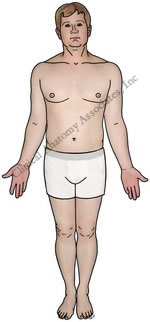|
The use of directions when working with the human body can be problematic, if not critical. When a surgeon indicates to his assistant to "cut towards the left", whose left is he referring to? the assistant's left? the anesthesiologist's left? the surgeon's left?. This is even life-threatening if we are talking about a pneumonectomy, a nephrectomy, or any surgical manipulation of a bilateral organ. The situation is complicated by the position of the patient on the surgical table. If the patient is prone (face down) where is "down"? What if the patient is placed in a reverse Trendelenburg position? The examples of directional mistakes can go on and on, and they are in many cases cause for problems. The need for specific directional terminology for the human body is critical. This is why physicians and anatomists refer to the human body as if the patient was in a standard position: the anatomical position (see image). In the anatomical position the subject is standing, face forward, with the heels together and the palms of the hands facing forward. Have you ever wondered why it is called the "back" of your hand, although it is almost always facing forward or up? If you hover your mouse over the image, you will see the midline or median plane. Image property of: CAA.Inc. Artist: Victoria G. Ratcliffe |

|
| MTD Main Page | Back to MTD Main Page |